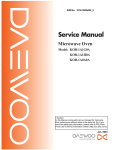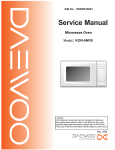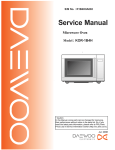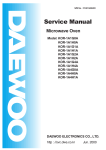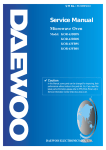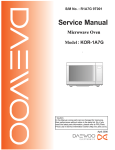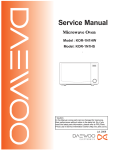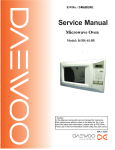Download Daewoo KOR-1A4H Service manual
Transcript
S/M No. : R1A0A0C002 Service Manual Microwave Oven Model : KOR-1A4H • Caution: In this Manual, some parts can be changed for improving, their performance without notice in the parts list. So, if you need the latest parts information, please refer to PPL(Parts Price List) in Service Information Center (http://svc.dwe.co.kr). MARCH. 2006 PRECAUTIONS TO BE OBSERVED BEFORE AND DURING SERVICING TO AVOID POSSIBLE EXPOSURE TO EXCESSIVE MICROWAVE ENERGY (a) Do not operate or allow the oven to be operated with the door open. (b) Make the following safety checks on all ovens to be serviced before activating the magnetron or other microwave source, and make repairs if necessary: (1) Interlock operation, (2) Proper door closing, (3) Seal and sealing surfaces (arcing, wear, and other damage), (4) Damage to or loosening of hinges and latches (5) Evidence of dropping or abuse. (c) Before turning on power to the microwave oven for any service test or inspection within the microwave generating compartments, check the magnetron, wave guide or transmission line, and cavity for proper alignment, integrity, and connections. (d) Any defective or misadjusted components in the interlock, monitor, door seal and microwave generation and transmission systems shall be repaired, replaced, or adjusted by procedures described in this manual before the oven is released to the owner. (e) A microwave leakage check to verify compliance with the Federal performance standard should be performed on each oven prior to release to the owner. TABLE OF CONTENTS SAFETY AND PRECAUTIONS........................................................................................................................................2 1. FOR SAFE OPERATION.......................................................................................................................................2 2. FOR SAFE SERVICE PROCEDURES .................................................................................................................2 SPECIFICATIONS ............................................................................................................................................................3 EXTERNAL VIEW .............................................................................................................................................................4 1. OUTER DIMENSION .............................................................................................................................................4 2. FEATURE DIAGRAM.............................................................................................................................................5 3. CONTROL PANEL.................................................................................................................................................6 INSTALLATION ................................................................................................................................................................8 OPERATIONS AND FUNCTIONS ...................................................................................................................................9 DISASSEMBLY AND ASSEMBLY ................................................................................................................................10 INTERLOCK MECHANISM AND ADJUSTMENT.........................................................................................................19 TROUBLE SHOOTING GUIDE ......................................................................................................................................20 MEASUREMENT AND TEST.........................................................................................................................................24 1. MEASUREMENT OF THE MICROWAVE POWER OUTPUT ...........................................................................24 2. MICROWAVE RADIATION TEST .......................................................................................................................25 3. COMPONENT TEST PROCEDURE ...................................................................................................................26 WIRING DIAGRAM.........................................................................................................................................................27 PRINTED CIRCUIT BOARD...........................................................................................................................................28 1. CIRCUIT CHECK PROCEDURE.........................................................................................................................28 2. PCB CIRCUIT DIAGRAM ....................................................................................................................................31 3. P.C.B. LOCATION NO. ........................................................................................................................................32 EXPLODED VIEW AND PARTS LIST ...........................................................................................................................33 1. DOOR ASSEMBLY ..............................................................................................................................................33 2. CONTROL PANEL ASSEMBLY ..........................................................................................................................33 3. TOTAL ASSEMBLY .............................................................................................................................................33 1 SAFETY AND PRECAUTIONS CAUTION : This Device is to be Serviced Only by Properly Qualified Service Personnel. Consult the Service Manual for Proper Service Procedures to Assure Continued Safety Operation and for Precautions to be Taken to Avoid Possible Exposure to Excessive Microwave Energy. 1. FOR SAFE OPERATION Damage that allows the microwave energy (that cooks or heats the food) to escape will result in poor cooking and may cause serious bodily injury to the operator. IF ANY OF THE FOLLOWING CONDITIONS EXIST, OPERATOR MUST NOT USE THE APPLIANCE. (Only a trained service personnel should make repairs.) 1) A broken door hinge. 2) A broken door viewing screen. 3) A broken front panel, oven cavity. 4) A loosened door lock. 5) A broken door lock. The door gasket plate and oven cavity surface should be kept clean. No grease, soil or spatter should be allowed to build up on these surfaces or inside the oven. DO NOT ATTEMPT TO OPERATE THIS APPLIANCE WITH THE DOOR OPEN. The microwave oven has concealed switches to make sure the power is turned off when the door is opened. Do not attempt to defeat them. DO NOT ATTEMPT TO SERVICE THIS APPLIANCE UNTIL YOU HAVE READ THIS SERVICE MANUAL. 2. FOR SAFE SERVICE PROCEDURES 1) If the oven is operative prior to servicing, a microwave emission check should be performed prior to servicing the oven. 2) If any certified oven unit is found to servicing, a microwave emission check should be performed prior to servicing the oven. (a) inform the manufacturer, importer or assembler, (b) repair the unit at no cost to the owner, (c) attempt to ascertain the cause of the excessive leakage, (d) tell the owner of the unit not to use the unit until the oven has been brought into compliance. 3) If the oven operates with the door open, the service person should tell the user not to operate the oven and contact the manufacturer and CDRH immediately. IMPORTANT : The wire in this mains lead coloured in accordance with the following code. Green-and-yellow : Earth Blue : Neutral Brown : Live As the colours of the wires in the manins lead of this appliance may not correspond with the coloured markings identifying the terminals in your plug, proceed as follows. The wire which is loloured green-and-yellow must be connected to the termianl in the plug which is marked with the letter ‘E’, earth symbol or coloured green-and-yellow. The wire which is coloured blue must be connected to the terminal which is marked with the letter ‘N’ or coloured black. The wire which is coloured brown must be connected to the terminal which is marked the letter ‘L’ or coloured red. NOTE : This oven is designed for counter-top use only. 2 SPECIFICATIONS MODEL KOR-1A0A/1A6A POWER SUPPLY POWER CONSUMPTION KOR-1A4H 127V~60Hz, SINGLE PHASE WITH EARTHING MICROWAVE 1400 W GRILL COMBINATION MICROWAVE ENERGY OUTPUT 1000W MICROWAVE FREQUENCY 2450MHz OUTSIDE DIMENSIONS (W X H X D) 539X300X406mm CAVITY DIMENSIONS (W X H X D) 539X300X435mm 354X228X373mm NET WEIGHT APPROX. 15.5kg APPROX. 16.5kg TIMER 99 min. 90 sec. FUNCTION SELECTIONS MICROWAVE POWER SELECTIONS 10 LEVELS CAVITY VOLUME 1.1 Cu. Ft KOR-1A4H 435 300 539 3 DIAGRAMA DE CARACTERISTICAS 1 2 3 4 5 8 6 7 1. Ganchos del seguro de la puerta - Este horno funciona solamente cuando la puerta está cerrada totalmente. Si se abre la puerta, el horno deja de funcionar y de producir microondas, hasta que la puerta se vuelve a cerrar. 6. Plato de cristal - Fabricado con cristal especial, resistente al calor. El plato siempre debe colocarse en su eje antes del funcionamiento. No cocine los alimentos directamente sobre el plato. 7. Arillo - Sostiene al plato de cristal para que este pueda girar. 2. Sello de la puerta - Este sello mantiene a las microondas dentro de la cavidad y asimismo previene la fuga de éstas. 8. Ventanilla de puerta - permite observar los alimentos. Esta ventanilla ha sido diseñada para permitir la vista al interior de la cavidad y al mismo tiempo impedir la salida de las microondas. 3. Cavidad del horno 4. Cubierta protectora - Evita que la salida de las microondas se salpique cuando los alimentos se cocinan. 5. Sistema de sujeción con seguro Previene que el horno funcione mientras la puerta se encuentra abierta. 5 DIAGRAMA DE CARACTERISTICAS (CONTINUACION) 0 q w e r t 9 y u i o p 15. Potencia - Botón para establecer el nivel de potencia de cocinado. 9. Botones numéricos- Se usan para seleccionar el tiempo de cocción de los alimentos y la hora actual. 16. Descongelado - Función para descongelar cualquier tipo de alimentos, mediante la indicación de tiempo. 10. Pantalla - En esta pantalla se muestra la hora del reloj, así como el tiempo de cocción, nivel de potencia y demás indicaciones. 17. Alarma / Com. Auto. - Función de uso múltiple que puede utilizarse como alarma de cocina, para la adición de tiempo de reposo o como función de encendido automático. 11. Botones de cocinado en un toque - Son usados para cocinar o recalentar fácilmente cantidades específicas de alimentos. 18. Reloj - Para ajustar la hora del reloj. 12. Más - Función para agregar más tiempo de cocción con un solo toque. 19. Parar / Borrar - Botón usado para detener el funcionamiento del horno o para cancelar alguna indicación no deseada. 13. Menos- Función para disminuir el tiempo de cocción con un solo toque. 20. Comienzo / Cocción rápida - Sirve para indicar que el horno comience su operación de cocinado; también se usa para efectuar el recalentado en intervalos de 30 segundos. 14. Descongelado automático - Funciones programadas para descongelar carne, pollo o pescado, según el peso. 7 INSTALLATION 1. Steady, flat location. This oven should be set on a steady, flat surface. This oven is designed for counter top use only. 2. Leave space behind and side All air vents should be kept a clearance. If all vents are covered during operation, the oven may overheat and, eventually, oven failure. The minimum height of free space necessary above the top surface of the oven is minimum 100mm. 3. Away from radio and TV sets Poor television reception and radio interference may result if the oven is located close to a TV, Radio antenna, feeder and so on. Position the oven as far from them as possible. 4. Away from heating appliance and water taps Keep the oven away from hot air, steam or splash when choosing a place to position it, or the insulation might be adversely affected and breakdowns occur. 5. Power supply • Check your local power source. This oven requires a current of approximately 12 amperes, 127V 60Hz. • Power supply cord is about 0.6 meters long. • The voltage used must be the same as specified on this oven. Using a higher voltage may result in a fire or other accident causing oven damage. Using low voltage will cause slow cooking. We are not responsible for damage resulting from use of this oven with a voltage of ampere fuse other than those specified. • If the supply cord is damaged, it must be replaced by the manufacturer or its service agent or a similarity qualified person in order to avoid a hazard. 6. Examine the oven after unpacking for any damage such as: A misaligned door, Broken door, A dent in cavity. If any of the above are visible, DO NOT INSTALL, and notify dealer immediately. 7. Do not operate the oven if it is colder than room temperature. (This may occur during delivery in cold weather.) Allow the oven to become room temperature before operating. EARTHING INSTRUCTIONS This appliance must be earthed. In the event of an electrical short circuit, earthing reduces the risk of the electric shock by providing an escape wire for the electric current. This appliance is equipped with a cord having a earthing wire with a earting plug. The plug must be plugged into an outlet that is properly installed and earthed. CAUTION : Improper use of the earthing plug can result in a risk of electric shock. Consult a qualified electrician or serviceman if the earthing instructions are not completely understood, or if doubt exists as to whether the appliance is properly earthed, and either : If it is necessary to use an extension cord, use only a 3-wire extension cord that has a 3-blade earthing plug, and a 3-slot receptacle that will accept the plug on the appliance. The marked rating of the extension cord should be equal to or greater than the electrical rating of the appliance, or Do not use an extension cord. 8 OPERATIONS AND FUNCTIONS 1. Connect the main lead to an electrical outlet. 2. After placing the food in a suitable container, open the oven door and put it on the glass tray. The glass tray must always be in place during cooking. 3. Close the door securely. 4. The oven door can be opened at any time during operation by touching the door release button on the control panel. The oven will automatically shut off. To restart the oven, close the door and then touch START. 5. Each time a pad is touched, a BEEP will sound to acknowledge the touch. 6. The oven automatically cook on full power unless set to a lower power level. 7. The display will show : 0 when the oven is plugged in. 8. Time clock returns to the present time when the cooking time ends. 9. When the STOP/CLEAR pad is touched during the oven operation, the oven stops cooking and all information retained. To erase all information (except the present time), touch the STOP/CLEAR pad once more. If the oven door is opened during the oven operation, all information is retained. 10. If the START pad is touched and the oven does not operate, check the area between the door and door is closed securely. The oven will not start cooking under the door is completely closed or the program has been reset. Make sure the oven is properly installed and plugged into the electrical outlet. Wattage output chart The power level is set by pressing the POWER pad. The chart shows the display, the power level and the percentage of power. Touch POWER pad. Power level(Display) Approximate Percentage of Power Once P-HI 100% Twice P-90 90% 3 times P-80 80% 4 times P-70 70% 5 times P-60 60% 6 times P-50 50% 7 times P-40 40% 8 times P-30 30% 9 times P-20 20% 10 times P-10 10% 11 times P-00 0% 9 DISASSEMBLY AND ASSEMBLY - Cautions to be observed when trouble shooting. Unlike many other appliances, the microwave oven is high-voltage, high-current equipment. It is completely safe during normal operation. However, carelessness in servicing the oven can result in an electric shock or possible danger from a short circuit. You are asked to observe the following precautions carefully. 1. Always remove the power plug from the outlet before servicing. 2. Use an insulated screwdriver and wear rubber gloves when servicing the high voltage side. 3. Discharge the high voltage capacitor before touching any oven components or wiring. (1) Check the grounding. Do not operate on a two-wire extension cord. The microwave oven is designed to be used while grounded. It is imperative, therefore, to make sure it is grounded properly before beginning repair work. (2) Warning about the electric charge in the high voltage capacitor. For about 30 seconds after the operation has stopped, electric charge remains in the high voltage capacitor. When replacing or checking parts, short between oven chassis and the negative high terminal of the high voltage capacitor by using a properly insulated screwdriver to discharge. 4. When the 15A fuse is blown due to the operation of the monitor switch; replace primary interlock switch, secondary interlock switch and interlock monitor switch. 5. After repair or replacement of parts, make sure that the screws are properly tightened, and all electrical connections are tightened. 6. Do not operate without cabinet. CAUTION : Service personnel should remove their watches whenever working close to or replacing the magnetron. CAUTION : When servicing the appliance, take care when touching or replacing high potential parts because of electrical shock or exposing microwave. These parts are as follows - HV Transformer, Magnetron, HV Capacitor. 10 1. To remove cabinet 1) Remove three screws on cabinet back. 2) Push the cabinet backward. 2. To remove door assembly 1) Remove two screws which secure the stopper hinge top. 2) Remove the door assembly from top plate of cavity. 3) Reverse the above for reassembly. NOTE : After replacing the door assembly, perform a check of correct alignment with the hinge and cavity front plate. 11 KOR-1A4H A13 A08 A12 A04 A05 A02 A06 A03 A07 A11 A09 A10 REF NO. PART CODE PART NAME DESCRIPTION Q’TY A01 3511711300 DOOR PAINTING AS KOR-1A1G0A 1 A02 3513100730 HOOK POM BLACK 1 A03 3515101900 SPRING HOOK HSW-3 1 A04 3517005910 BARRIER-SCREEN * O GLASS T3.2 1 A05 3512204320 FRAME DOOR ABS XR-401 SG-175 1 A06 3511604700 DECORATOR DOOR * T STS304 T0.6 1 A07 3511604710 DECORATOR DOOR * U STS304 T0.6 1 A08 3515202900 STOPPER HINGE * T AS KOR-121M0A 1 A09 3512603400 HANDLE DOOR * T STS304 T0.6 HAIR LINE 1 A10 3512603300 HANDLE DOOR * U ABS XR-401 H-2938 1 A11 7122401211 SCREW TAPPING T2S TRS 4*12 MFZN 2 A12 3517005800 BARRIER-SCREEN * I PETP T0.1 1 A13 3512301900 GASKET DOOR PP 1 (1) Remove the gasket door from door plate. (2) Remove the barrier screen inner from door plate. (3) Remove the door frame from door plate. (4) Remove the stopper hinge top from door plate. (5) Remove the spring and the hook. (6) Remove the barrier screen outer from door frame. (7) Remove two screws holding the handle. (8) Remove the handle from door frame. (9) Reverse the above steps for reassembly. 13 REMARK 4. Method to reduce the gap between the door seal and the oven front surface. (1) To reduce gap located on part ‘A’. • Loosen two screws on stopper hinge top, and then push the door to contact the door seal to oven front surface. • Tighten two screws. A C (2) To reduce gap located on part ‘B’. • Loosen two screws on stopper hinge under, and then push the door to contact the door seal to oven front surface. • Tighten two screws. B D (3) To reduce gap located on part ‘C’. • Loosen a screw on interlock switch assembly located top of oven body. • Draw the interlock switch assembly inward as possible to engage with hook on the door bottom. • Tighten a screw. (4) To reduce gap located on part ‘D’. • Loosen a screw on interlock switch assembly located bottom of oven body. and (4) are same as step (3). NOTE : A small gap may be acceptable if the microwave leakage does not exceed 4mW/cm2. 14 KOR-1A4H REF NO. PART CODE PART NAME DESCRIPTION Q’TY B01 3511604800 DECORATOR C-PANEL STS304 T0.6 1 B02 3518570930 SWITCH MEMBRANE KOR-1A4H0S 1 B03 3516722320 CONTROL-PANEL ABS SG-175 SG-0760D 1 B04 PKCPSWXR00 PCB AS KOR-1A0A0C 1 B05 7122401211 SCREW TAPPING T2S TRS 4* 12 MFZN 3 REMARK (1) Remove the screw which secure the control panel, push up two snap fits and draw forward the control panel assembly. (2) Remove four screws which secure the PCB assembly to control panel. (3) Disconnect membrane tail from the connector of the PCB assembly. (4) Detach membrane from the control panel. (5) Reverse the above steps for reassembly. 16 6. To remove high voltage capacitor. 1) Remove a screw which secure the grounding ring terminal of the H.V.diode and the capacitor holder. 2) Remove the H.V. diode from the capacitor holder. 3) Reverse the above steps for reassembly. ◆ High voltage circuit wiring 7. To remove magnetron. 1) Remove a screw which secure the magnetron. 2) Remove the magnetron. 3) Reverse the above steps for reassembly. NOTE : Never install the magnetron without the metallic gasket plate which is packed with each magnetron to prevent microwave leakage. Whenever repair work is carried out on magnetron, check the microwave leakage. It shall not exceed 4mW/cm2 for a fully assembled oven with door normally closed. 17 8. To remove wind guide assembly. 1) Remove a screw which secure the wind guide assembly. 2) Draw forward the wind guide assembly. 3) Pull the fan from the motor shaft. 4) Remove two screws which secure the motor shaded pole. 5) Remove the motor shaded pole. 6) Reverse the above steps for reassembly. 9. To remove H.V.transformer. 1) Remove four screws holding the H.V.transformer. 2) Remove the H.V.transformer. 3) Reverse the above steps for reassembly. 18 INTERLOCK MECHANISM AND ADJUSTMENT The door lock mechanism is a device which has been specially designed to completely eliminate microwave radiation when the door is opened during operation, and thus to perfectly prevent the danger resulting from the leakage of microwave. 2) KOR-1A4H (1) Primary interlock switch When the door is closed, the hook locks the oven door. If the door is not closed properly, the oven will not operate. When the door is closed, the hook pushes the button of the microswitch. Then the button of the primary interlock switch bring it under ON condition. (2) Secondary interlock switch and interlock monitor switch When the door is closed, the hook pushes the lock lever downward. The lock lever presses the button of the interlock monitor switch to bring it under NO condition and presses the button of the secondary interlock switch to bring it under ON condition. ADJUSTMENT : Interlock monitor switch When the door is closed, the interlock monitor switch should be changed (NO condition) before other switches are closed. When the door is opened, the interlock monitor switch should be changed (NC condition) after other switches are opened. (3) Adjustment steps a) Loosen the one mounting screw. b) Adjust interlock switch assembly position. c) Make sure that lock lever moves smoothly after adjustment is completed. d) Tighten completely two mounting screws. NOTE : Microwave emission test should be performed after adjusting interlock mechanism. If the microwave emission exceed 4mW/cm2, readjust interlock mechanism. 19 TROUBLE SHOOTING GUIDE Following the procedure below to check if the oven is defective or not. 1) Check grounding before trouble checking. 2) Be careful of the high voltage circuit. 3) Discharge the high voltage capacitor. 4) When checking the continuity of the switches, fuse or high voltage tranformer, disconnect one load wire from these parts and check continuity with the AC plug removed. To do otherwise may result in a false reading or damage to your meter. NOTE : When electric parts are checked, be sure the power cord is not inserted the wall outlet. Check wire harness, wiring and connection of the terminals and power cord before check the parts listed below. (TROUBLE 1) Oven does not operate at all : any inputs can not be accepted. CONDITION CHECK RESULT Check continuity of interlock monitor switch with door closed Continuity Fuse blows. CAUSE Malfunction of interlock monitor switch REMEDY Replace NOTE 1 No Continuity Replace fuse Check continuity of of primary interlock switch contact with door partially open until interlock monitor switch contact close Check continuity of primary winding of low voltage transformer Continuity 0Ω or infinite Approx. 150~310 (normal) Normal Disconnect one side of the lead wire connected form high voltage transformer to the high voltage capacitor and operate the unit Fuse again blows 20 Shorted contacts of primary interlock switch. Defective low voltage transformer Defective high voltage capacitor Defective high voltage transformer Replace NOTE 1 Replace Replace Replace CONDITION Outlet has proper voltage Fuse does not blow. CHECK RESULT CAUSE REMEDY No Continuity Defective magnetron Replace Check continuity of magnetron Check continuity of power supply cord No Continuity Open power supply cord Replace Normal Defective touch control circuit Replace Malfunction of secondary interlock switch Replace Display do not shown countdown NOTE All these switches must be replaced at the same time, please refer to “Interlock Mechanism And Adjustment”. (TROUBLE 2) Display shows all figures selected, but oven does not start cooking, even though desired program and time are set and start pad is tapped. CONDITION CHECK RESULT CAUSE REMEDY Turn table motor and oven lamp do not turn on Check continuity of primary interlock switch No Continuity Malfunction of primary interlock switch Adjust or replace Check continuity of secondary interlock switch No Continuity Malfunction of secondary interlock switch Adjust or replace Check D.C. voltage being supplied to RELAY (RY2) coil 0V Defective touch control circuit Replace Approx. 15 VDC Faulty contacts of RELAY (RY2) or open relay coil 21 Replace (TROUBLE 3) No microwave oscillation even though fan motor rotates. CONDITION No microwave oscillation CHECK RESULT CAUSE REMEDY Check continuity of high voltage capacitor terminals with wires removed Continuity Defective high voltage transformer Replace Check continuity of high voltage rectifier in forward and backward direction with DC megger Continuity in backward direction Defective high voltage rectifier Replace Connect megger leads to magnetron terminal and magnetron body Continuity Defective magnetron Replace Defective high voltage transformer Replace 0 Ω or ∞ Check resistance of primary and secondary coil of high voltage transformer No Continuity Check continuity of magnetron with wires removed No Continuity Check continuity of filament terminal of high voltage transformer Defective magnetron Defective high voltage transformer 0V Check D.C. voltage being supplied to RELAY (RY1) coil Defective touch control circuit Approx 15 VDC 22 Faulty contacts or RELAY (RY1) or open relay coil Replace Replace Replace Replace (TROUBLE 4) The following visual conditions inditions indicate a probable defective touch control circuit or membrane switch assembly 1. Incomplete segments, 1) Segments missing. 2) Partical segments missing. 3) Digit flickering other than normal display slight flickering. 4) " :0" does not display when power is on. 2. A distinct change in the display are not on when they numbers is the display. M/W DEF TIMER LOCK g 3. One or more digits in the display are not on when they should be. 4. Display indicates a number different from one touched. 5. Specific numbers (for example 2 or 3) will not display when the panel is touched. 6. Display does not count down or up with time cooking or clock operation. 7. Oven is programmable and cooks normally but no display shows. 8. Display obviously jumps in time while counting down. 9. Display counts down noticeable too fast while cooking. 10. Display does not show the time of day when clear pad is touched. 11. Oven lamp and turntable motor do not stop although cooking is finished. Check if the RELAY 2 contacts close if they are close, replace touch control circuit. CONDITION CHECK Display does not show programming at all, even if keyboard is touched. Check rach pad for continuity of the membrane keyboard for the following keyboard check procedure RESULT Normal Abnormal CAUSE REMEDY Malfunction of touch control circuit of control box sub-assembly Replace control box sub-assembly Malfunction of the membrane keyboard Replace the membrane keyboard NOTE Before following the particular steps listed above in the trouble shooting guide for the membrane keyboard's, failure, please check for the continuity of each wire-harness between the membrane keyboard and P.C.B. assembly. 23 MEASUREMENT AND TEST 1. MEASUREMENT OF THE MICROWAVE POWER OUTPUT Microwave output power can be checked by indirectly measuring the temperature rise of a certain amount of water exposed to the microwave as directed below. PROCEDURE 1. Microwave power output measurement is made with the microwave oven supplied at rated voltage and operated at its maximum microwave power setting with a load of 1000 ± 5cc of potable water. 2. The water is contained in a cylindrical borosilicate glass vessel having a maximum material thickness of 3 mm and an outside diameter of approximately 190 mm. 3. The oven and the empty vessel are at ambient temperature prior to the start of the test. The initial temperature of the water is 10 ± 2°C (50 ± 3.6°F). It is measured immediately before the water is added to the vessel. After addition of the water to the vessel, the load is immediately placed on the center of the shelf, which is in the lowest normal position. 4. Microwave power is switched on. 5. Heating time should be exactly A seconds. (Refer to table as following) Heating time is measured while the microwave generator is operating at full power. The filament heatup time for magnetron is not included. 6. The initial and final temperature of water is selected so that the maximum difference between the ambient and final water temperature is 5K. 7. The microwave power output P in watts is calculated from the following formula: P = 4187 X ∆ T/t • ∆ T is difference between initial and ending temperature. • t is the heating time. The power measured be B (Refer to SPECIFICATIONS) W ± 10.0 %. CAUTION 1. Water load should be measured exactly to 1 liter. 2. Input power voltage should be exactly specified voltage (Refer to SPECIFICATIONS). 3. Ambient temperature should be 20 ± 2°C (68 ± 3.6°F) ✻ Heating time for power output: A (second) 70 64 60 56 52 49 47 44 42 40 38 B (W) 600 650 700 750 800 850 900 950 1000 1050 1100 24 2. MICROWAVE RADIATION TEST CAUTION 1. Make sure to check the microwave leakage before and after repair of adjustment. 2. Always start measuring of an unknown field to assure safety for operating personnel from microwave energy. 3. Do not place your hands into any suspected microwave radiation field unless the safe density level is known. 4. Care should be taken not to place the eyes in direct line with the source of microwave energy. 5. Slowly approach the unit under test until the radiometer reads an appreciable microwave leakage from the unit under the test. PROCEDURE 1. Prepare Microwave Energy Survey Meter, 600cc glass beaker, and glass thermometer 100°C (212°F). 2. Pour 275cc ± 15cc of tap water initially at 20 ± 5°C (68 ± 9°F) in the 600 cc glass beaker with an inside diameter of approx. 95 mm(3.5 in.). 3. Place it at the center of the tray and set it in a cavity. 4. Close the door and operate the oven. 5. Measure the leakage by using Microwave Energy Survey Meter with dual ranges, set to 2450MHz. 1) Measured radiation leakage must not exceed the value prescribed below. Leakage for a fully assembled oven with door normally closed must be less than 4mW/cm2. 2) When measuring the leakage, always use the 5 cm (2 in.) space cone with probe. Hold the probe perpendicular to the cabinet and door. Place the space cone of the probe on the door, cabinet, door seem, door viewing screen, the exhaust air vents and the suction air vents. 3) Measuring should be in a counter-clockwise direction at a rate of 1 in./sec. If the leakage of the cabinet door seem is unknown, move the probe more slowly. 4) When measuring near a corner of the door, keep the probe perpendicular to the areas making sure the probe end at the base of the cone does not get closer than 2 in. from any metal. If it does not, erroneous reading may result. 25 3. COMPONENT TEST PROCEDURE • High voltage is present at the high voltage terminal of the high voltage transformer during any cooking cycle. • It is neither necessary nor advisable to attempt measurement of the high voltage. • Before touching any oven components or wiring, always unplug the oven from its power source and discharge the capacitor. 1. High voltage transformer 1) Remove connections from the transformer terminals and check continuity. 2) Normal readings should be as follows : Secondary winding ... Approx. 90 Ω±10% Filament winding ... Approx. 0 Ω Primary winding ... Approx. 1 Ω 2. High voltage capacitor 1) Check continuity of capacitor with meter on the highest OHM scale. 2) A normal capacitor will show continuity for a short time, and then indicate 10MΩ once the capacitor charged. 3) A shorted capacitor will show continuous continuity. 4) An open capacitor will show constant 10MΩ. 5) Resistance between each terminal and chassis should be infinite. 3. High voltage diode 1) Isolate the diode from the circuit by disconnecting the leads. 2) With the ohmmeter set on the highest resistance scale measure the resistance across the diode terminals. Reverse the meter leads and again observe the resistance reading. Meter with 6V, 9V or higher voltage batteries should be used to check the front-back resistance of the diode, otherwise an infinite resistance may be read in both directions. A normal diode's resistance will be infinite in one direction and several hundred k Ω in the other direction. 4. Magnetron For complete magnetron diagnosis, refer to "Measurement of the Microwave Power Output." Continuity checks can only indicate and open filament or a shorted magnetron. To diagnose for an open filament or a shorted magnetron, 1) Isolate magnetron from the circuit by disconnecting the leads. 2) A continuity check across magnetron filament terminals should indicate 0.1 Ω or less. 3) A continuity check between each filament terminal and magnetron case should read open. 5. Fuse If the fuse in the primary and monitor switch circuit is blown when the door is opened, check the primary and monitor switch before replacing the blown fuse. In case the fuse is blown by an improper switch operation, replace the defective switch and fuse at the same time. Replace just the fuse if the switches operate normally. 26 H.V. FUSE WIRING DIAGRAM 27 PRINTED CIRCUIT BOARD 1. CIRCUIT CHECK PROCEDURE 1. Low voltage transformer check The low voltage transformer is located on the P.C.B. Measuring condition: Input voltage: 127V / Frequency: 60Hz Terminal Voltage LOAD NO LOAD 4-7 AC 12.6 V AC 14.7 V NOTE 1. Refer to Ciruit Diagram (point 4). 2. Secondary side voltage of the low voltage transformer changes in proportion to fluctuation of power source voltage. 3. The allowable tolerance of the secondary voltage is within ± 5% of nominal voltage. 2. Voltage Check - Key check point NO CHECK POINT 1 IC1 PIN 2, 21, 30, 34 2 IC1 PIN 35 REMARK -5VDC T : 16.67ms(60Hz) 3 IC1 PIN 31 OR 32 T : 250 ns(4MHz) - Check method NO MEASURE POINT WAVE FORM REMEDY REMARK 1 MP1 DC -5V±0.25V Replace VL1, EC1 NO LOAD 2 MP2 DC -12V±2.0V Replace EC2, D12,13,14 NO LOAD NOTE Each measure point must be measured with GND points. 28 3. When there is no microwave oscillation 1) When touching START pad, oven lamp does not turn on. Fan motor do not rotate, but cook indicator in display comes on. ✻ Cause : RELAY 2 does not operate. → refer to Circuit Diagram (point 3) - Check method POINT A B RELAY 2 ON -5VDC GND RELAY 2 OFF GND -12VDC STATE 2) When touching START pad, oven lamp turns on. Fan motor and turntable rotate and cook indicator in display comes on. ✻ Cause : RELAY 1 does not operate. → refer to Circuit Diagram (point 2) - Check method POINT A B RELAY 1 ON -5VDC GND RELAY 1 OFF GND -12VDC STATE 4. When the door is opened during operation the count down timer does not stop. → refer to Circuit Diagram (point 1) - Check method POINT A B 1) DOOR OPEN OPEN -5VDC 2) DOOR CLOSED CLOSE GND STATE CHECK NO 1 METHOD REMEDY Check the stage(ON, OFF) of the secondary interlock switch by resistance measurement. Replace door open monitor switch. 6. When the digital clock does not operate properly. → refer to Circuit Diagram (point 5) POINT A WAVE FORM T: 16.67 ms(60Hz) ❈ If clock does not keep exact time, you must check resistor R15,16, zener diode ZD1. 30 31 3 2 1 3 2 CN3 4 1 3 CN1 7 6 4 LVT1 V2:-12V V1:-5V (TRAY LAMP) RY2 (MAGNETRON) RY1 1 5 D14 EC2 D6 R19 D10 D9 D.O.M SW D13 2 1 + - V2 R8 R10 ZD2 A V2 V1 R16 D12 D11 R22 V1 V1 R14 R13 C7 V2 B B Q6 R15 VL1 C1 R23 R12 CR1 - EC1 + R17 ZD1 D15 V1 C6 V1 Q10 Q9 V1 R9 R18 C4 C3 C5 A V1 A A B V1 R11 VASS GND TEST HOLD 4 AIN1 32 XOUT 31 XIN 33 RESET 35 INT2 1 VAREF 42 VCC 2 21 30 34 14 R63 13 R62 3 R40 41 R92 R53 10 R52 9 R51 8 R50 7 R43 6 R42 5 P71 16 P70 15 K00 26 K01 27 K02 28 K03 29 R91 40 R90 39 R83 38 R82 37 R81 36 P22 24 P21 23 P20 22 P13 20 P12 19 P11 18 P10 17 CA1 V1 RA1 R21 R20 Q1 V1 11 10 9 8 7 6 SJ6 SJ5 SJ4 SJ3 SJ2 SJ1 9 4 STOP/ CLEAR MEAT PASTA POPCORN Q2 5 8 3 SPEEDY COOK START/ POULTRY DINNER PLATE FROZEN PIZZA D5 Q5 Q3 R5 R6 R7 R2 R1 R3 R4 4 7 10SEC 2 DEFROST FISH DISH WARMER BEVERAGE D4 Q4 3 6 1MIN 1 AUTO COOK CLOCK MORE(+) FRESH VEGETABLE D3 2 G5 G4 G3 G2 G1 f a c d e b g 5 10MIN 0 POWER KITCHEN TIMER LESS(-) FROZEN VEGETABLE D1 12 11 9 8 4 3 2 1 5 10 7 6 1 G5 G4 BZ1 IC1 d c g e d c g D2 CN2 d c g G2 G1 e d c g e e b f DP1 e b f b f b f f a a a a g d c b a Q11 2. P.C.B. CIRCUIT DIAGRAM G3 3. P.C.B. LOCATION NO. NO NAME SYMBOL SPECIFICATION PART CODE Q’TY 1 BUZZER BZ1 BM-20K 3515600100 1 2 C ARRAY CA1 7P(6) 102 M 50V CN6XB-102M 1 3 CAPACITOR ELEC EC1 50V RS 1•ÏF CEXE1H109A 1 4 CPAPCITOR ELEC EC2 25V RSS 1000•ÏF CEXF1E102V 1 5 CONNECTOR WAFER CN1 YW396-02V 3519150520 1 6 CONNECTOR WAFER CN3 YW396-05AV 3519150510 1 7 CONNECTOR WAFER CN2 FCZ254-11 441M367160 1 8 DIODE RECTIFY D1~6, 9~12, 15 1N4148 DZN4148 11 9 DIODE RECTIFY D13, 14 1N4004A DZN4004A-- 2 10 DIODE ZENER ZD1 UZ-5.1BSB DZUZ5R1BSB 1 11 DIODE ZENER ZD2 UZ-3.9BSB DZUZ3R9BSB 1 12 LED DISPLAY DP1 DDG-631H DDDG631H01 1 13 PCB MAIN M158 81.5X139.9 3514315410 1 14 R ARRAY RA1 7P(6) 1/8 100K J RA-87X104J 1 15 RESISTOR R1~R7 1/6W 330 J RD-AZ331J- 7 16 RESISTOR R8, 10, 14, 22 1/6W 1K J RD-AZ102J- 4 17 RESISTOR R9 1/6W 20K J RD-AZ203J- 1 18 RESISTOR R12, 23 1/6W 4.7K J RD-AZ472J- 2 18 RESISTOR R11, 20, 21 1/6W 100K J RD-AZ204J- 3 19 RESISTOR R13 1/6W 200 J RD-AZ201J- 1 20 RESISTOR R15~16 1/6W 10K J RD-AZ103J- 2 21 RESISTOR R18 1/6W 1M J RD-AZ511J- 1 22 RESISTOR R19 1/6W 51 J RD-AZ105J- 1 23 RESISTOR R17 1/6W 10K J RD-AZ511J- 1 25 REGULATOR VL1 MC7905C 1MC7905C-- 1 26 TRANSISTOR Q1~5, 9~11 KRA-106M TZRA106M-- 8 27 TRANSISTOR Q6 KTA-1266Y TZTA1266Y- 1 28 TRANS POWER LVT1 DMR-631PF 5EPV035306 1 29 WIRE COPPER J1~J3,J5~J8,J10~12,J17~21 1/0.52 TIN COATING 85801052GY 15 30 WIRE COPPER SJ4,5 1/0.52 TIN COATING 85801052GY 2 31 IC MICOM IC1 TMP47C440BN-3FC2 13GS1A1GH0 1 32 RESONATOR CERA CR1 KBR-4.0MSTF 5PKBR40MKS 1 33 SW RELAY RY1 G5G-1A DC 12V 5SC0101121 2 34 SW RELAY RY2 CS11-12 SH 1C 1P 5SC0101128 1 35 CAPACITOR CERA C6 102 50V Z AXIAL CCZB1H102K 1 36 CAPACITOR CERA C1, 3, 4, 5, 7 104 50V Z AXIAL CCZF1H104Z 5 32 EXPLODED VIEW AND PARTS LIST 1. DOOR ASSEMBLY Refer to Disassembly and assembly 2. CONTROL PANEL ASSEMBLY Refer to Disassembly and assembly 3. TOTAL ASSEMBLY 33 KOR-1A4H REF NO A00 B00 PART CODE PART NAME DESCRIPTION Q'TY 3511711220 DOOR AS KOR-1A4H 1 3511711230 DOOR AS KOR-1A0A 1 3511711240 DOOR AS KOR-1A6A 1 PKCPSWXR00 CONTROL-PANEL AS KOR-1A4H 1 PKCPSWXS10 CONTROL-PANEL AS KOR-1A0A 1 PKCPSWAP90 CONTROL-PANEL AS KOR-1A6A 1 F01 3510805500 CABINET AS KOR-1A1G0A LOUVER 1 F02 7112401011 SCREW TAPPING T1 TRS 4X10 MFZN 3 3516110400 CAVITY AS KOR-1A0A0C,1A4H0C,1A6A9C 1 3516110420 CAVITY AS KOR-1A0A0C22,1A4H0C22 1 F04 7122401211 SCREW TAPPING T2S TRS 4*12 MFZN 1 F05 7122401211 SCREW TAPPING T2S TRS 4*12 MFZN 1 F06 7112401011 SCREW TAPPING T1 TRS 4*10 MFZN 1 F07 35113N6K55 CORD POWER AS 3X1.5 40X40 120-RTML 1 F08 7122401211 SCREW TAPPING T2S TRS 4*12 MFZN 1 F09 5F1C020315 FUSE 250V 15A 1 F10 3518606100 NOISE FILTER DWLF-M13 1 F11 7112401011 SCREW TAPPING T1 TRS 4*10 MFZN 1 F12 7121403011 SCREW TAPPING T2S TRS 4*30 MFZN 2 F13 3963821600 MOTOR SHADED POLE 120V 60HZ MW10XA-M01 1 F14 3512517000 GUIDE WIND PP 1 F15 3511800300 FAN PP+30%GLASS 1 F16 3518002900 MAGNETRON 2M218J(F) P 1 F17 3516004000 SPECIAL SCREW T2 BOLT FLANGE 5X12 DACRO 1 F18 7272100811 SCREW TAPTITE TT3 TRS 4X8 MFZN 1 F19 3513003200 HOLDER HV CAPACITOR SECC T0.6 1 F20 3518302201 CAPACITOR HV 2100VAC 0.98UF #187 1 F21 3518400900 DIODE HV HR-1X-3AB 12KV #187 1 F22 3518700230 H.V. FUSE 5KV 0.7A 1 F23 3518119500 TRANS HV DT-R10C0-1AT 1 F24 3516003700 SPECIAL SCREW TT3 HEX 4X8 FLG MFZN 4 F25 3510312400 BASE SBHG T0.7 1 F26 7112401011 SCREW TAPPING T1 TRS 4X10 MFZN 5 F27 3512100900 FOOT PP DASF-130 2 F28 7272400811 SCREW TAPTITE TT3 TRS 4X8 MFZN 1 F29 3515202800 STOPPER HINGE*U AS KOR-121M0A 1 F03 34 REF NO PART CODE PART NAME DESCRIPTION Q'TY F30 3512716800 HARNESS MAIN KOR-1A1G0A 1 F31 4415A17352 SW MICRO VP-533A-OF SPNO#187 200G 1 F32 4415A66910 SW MICRO VP-531A-OF/SZM-V16-FA-61 2 F33 3518571000 SWITCH PUSH MP101C 1 3513702610 LEVER LOCK POM (KOR-1A4H) 1 3513702600 LEVER LOCK POM (KOR-1A0A/1A6A) 1 3513811710 LOCK POM BLACK (KOR-1A4H) 1 3513811700 LOCK POM BLACK (KOR-1A0A/1A6A) 1 F36 3513601500 LAMP BL 125V 25W T25 C5A H187 1 F37 7121400611 SCREW TAPPING T2S PAN 4X6 MFZN 1 F38 3966310200 MOTOR SYNCRO 120V 2W GM-16-12F17 1 F39 3518905400 THERMOSTAT OFF:90 ON:60 H#187 NB 1 F40 3513003410 HOLDER THERMOSTAT PP 1 F41 7272400811 SPECIAL TAPTITE TT3 TRS 4X8 MFZN 2 F42 3511406200 COVER WAVE GUIDE HEATPROOF PP 1 F43 3517400620 COUPLER XAREC 1 F44 3514701501 ROLLER TEFLON D:14.5 3 F45 3512519300 GUIDE ROLLER PP 5113MF6 1 F46 441CD35011 TRAY GLASS 1 F34 F35 35 DAEWOO ELECTRONICS CORP. 686, AHYEON-DONG MAPO-GU SEOUL, KOREA C.P.O. BOX 8003 SEOUL, KOREA TELEX: DWELEC K28177-8 CABLE: “DAEWOOELEC” S/M NO. : R1A0A0C002 PRINTED DATE: Nov. 2003


































